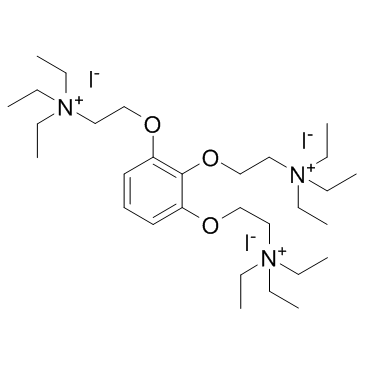Gallamine triethiodide

Gallamine triethiodide structure
|
Common Name | Gallamine triethiodide | ||
|---|---|---|---|---|
| CAS Number | 65-29-2 | Molecular Weight | 891.529 | |
| Density | 0.983g/cm3 | Boiling Point | 502.6ºC at 760 mmHg | |
| Molecular Formula | C30H60I3N3O3 | Melting Point | 235ºC (dec.) | |
| MSDS | Chinese USA | Flash Point | 125.9ºC | |
| Symbol |

GHS07 |
Signal Word | Warning | |
|
Translating clinical findings into knowledge in drug safety evaluation--drug induced liver injury prediction system (DILIps).
J. Sci. Ind. Res. 65(10) , 808, (2006) Drug-induced liver injury (DILI) is a significant concern in drug development due to the poor concordance between preclinical and clinical findings of liver toxicity. We hypothesized that the DILI types (hepatotoxic side effects) seen in the clinic can be tra... |
|
|
Developing structure-activity relationships for the prediction of hepatotoxicity.
Chem. Res. Toxicol. 23 , 1215-22, (2010) Drug-induced liver injury is a major issue of concern and has led to the withdrawal of a significant number of marketed drugs. An understanding of structure-activity relationships (SARs) of chemicals can make a significant contribution to the identification o... |
|
|
A predictive ligand-based Bayesian model for human drug-induced liver injury.
Drug Metab. Dispos. 38 , 2302-8, (2010) Drug-induced liver injury (DILI) is one of the most important reasons for drug development failure at both preapproval and postapproval stages. There has been increased interest in developing predictive in vivo, in vitro, and in silico models to identify comp... |
|
|
Chemical genetics reveals a complex functional ground state of neural stem cells.
Nat. Chem. Biol. 3(5) , 268-273, (2007) The identification of self-renewing and multipotent neural stem cells (NSCs) in the mammalian brain holds promise for the treatment of neurological diseases and has yielded new insight into brain cancer. However, the complete repertoire of signaling pathways ... |
|
|
Local Circuits for Contrast Normalization and Adaptation Investigated with Two-Photon Imaging in Cat Primary Visual Cortex.
J. Neurosci. 35 , 10078-87, (2015) Sensory neurons encode stimulus intensity in their instantaneous spike rate and adjust the set-points of the stimulus-response relationships by adaptation. In the visual cortex, adaptation is crucial because the mechanism of fast gain control (normalization) ... |
|
|
Regulation of blood flow in the retinal trilaminar vascular network.
J. Neurosci. 34(34) , 11504-13, (2014) Light stimulation evokes neuronal activity in the retina, resulting in the dilation of retinal blood vessels and increased blood flow. This response, named functional hyperemia, brings oxygen and nutrients to active neurons. However, it remains unclear which ... |
|
|
Development of a phospholipidosis database and predictive quantitative structure-activity relationship (QSAR) models.
Toxicol. Mech. Methods 18 , 217-27, (2008) ABSTRACT Drug-induced phospholipidosis (PL) is a condition characterized by the accumulation of phospholipids and drug in lysosomes, and is found in a variety of tissue types. PL is frequently manifested in preclinical studies and may delay or prevent the dev... |
|
|
Cross-talk between transforming growth factor-β₁ and muscarinic M₂ receptors augments airway smooth muscle proliferation.
Am. J. Respir. Cell. Mol. Biol. 49(1) , 18-27, (2013) Transforming growth factor-β₁ (TGF-β₁) is a central mediator in tissue remodeling processes, including fibrosis and airway smooth muscle (ASM) hyperplasia, as observed in asthma. The mechanisms underlying this response, however, remain unclear because TGF-β₁ ... |
|
|
Rebamipide suppresses mite-induced asthmatic responses in NC/Nga mice.
Am. J. Physiol. Lung Cell. Mol. Physiol. 309 , L872-8, (2015) Allergic asthma caused by continuous allergen exposure evokes allergen-specific Th2 responses and is characterized by chronic airway inflammation and hyperresponsiveness. A previous report showed that rebamipide improved asthmatic symptoms in an ovalbumin/try... |
|
|
Spinal sensory projection neuron responses to spinal cord stimulation are mediated by circuits beyond gate control.
J. Neurophysiol. 114 , 284-300, (2015) Spinal cord stimulation (SCS) is a therapy used to treat intractable pain with a putative mechanism of action based on the Gate Control Theory. We hypothesized that sensory projection neuron responses to SCS would follow a single stereotyped response curve as... |